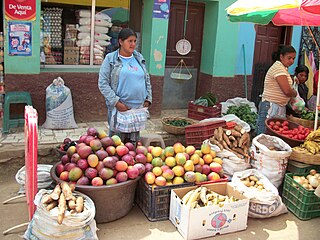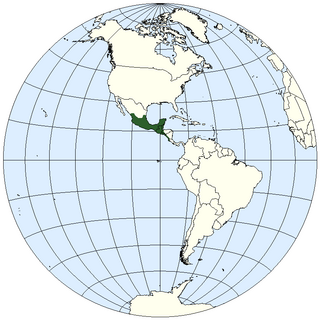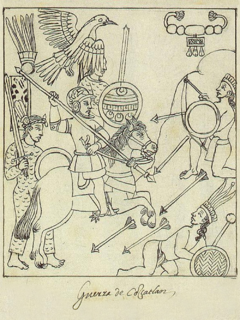The Mesoamerican region (often abbreviated MAR) is a trans-national economic region in the Americas that is recognized by the OECD and other economic and developmental organizations, comprising the united economies of the seven countries in Central America — Belize, Costa Rica, El Salvador, Guatemala, Honduras, Nicaragua, and Panama — plus nine southeastern states of Mexico — Campeche, Chiapas, Guerrero, Oaxaca, Puebla, Quintana Roo, Tabasco, Veracruz, and Yucatán. [1]
Economic geography has been defined by the geographers as the study of human's economic activities under varying sets of conditions which is associated with production, location, distribution, consumption, exchange of resources, and spatial organization of economic activities across the world. It represents a traditional subfield of the discipline of geography. However, many economists have also approached the field in ways more typical of the discipline of economics.

The Americas comprise the totality of the continents of North and South America. Together, they make up most of the land in Earth's western hemisphere and comprise the New World.

The Organisation for Economic Co-operation and Development is an intergovernmental economic organisation with 36 member countries, founded in 1961 to stimulate economic progress and world trade. It is a forum of countries describing themselves as committed to democracy and the market economy, providing a platform to compare policy experiences, seek answers to common problems, identify good practices and coordinate domestic and international policies of its members. Most OECD members are high-income economies with a very high Human Development Index (HDI) and are regarded as developed countries. As of 2017, the OECD member states collectively comprised 62.2% of global nominal GDP and 42.8% of global GDP at purchasing power parity. OECD is an official United Nations observer.
Contents
Designated as an 'economic territory' by the OECD, the identification of the Mesoamerican region as a focus for common regional economic development has been observed since the adoption in 2001 by the signatory countries of the Puebla-Panama Plan (PPP), an initiative intended to foster regional integration and development across southeastern Mexico and the countries of Central America. [2] The PPP also includes the country of Colombia; other than this, the territory and governments involved with the PPP are the same as those covered by OECD's Mesoamerican region.

Mexico, officially the United Mexican States, is a country in the southern portion of North America. It is bordered to the north by the United States; to the south and west by the Pacific Ocean; to the southeast by Guatemala, Belize, and the Caribbean Sea; and to the east by the Gulf of Mexico. Covering almost 2,000,000 square kilometres (770,000 sq mi), the nation is the fifth largest country in the Americas by total area and the 13th largest independent state in the world. With an estimated population of over 120 million people, the country is the eleventh most populous state and the most populous Spanish-speaking state in the world, while being the second most populous nation in Latin America after Brazil. Mexico is a federation comprising 31 states and Mexico City, a special federal entity that is also the capital city and its most populous city. Other metropolises in the state include Guadalajara, Monterrey, Puebla, Toluca, Tijuana and León.

Colombia, officially the Republic of Colombia, is a sovereign state largely situated in the northwest of South America, with territories in Central America. Colombia shares a border to the northwest with Panama, to the east with Venezuela and Brazil and to the south with Ecuador and Peru. It shares its maritime limits with Costa Rica, Nicaragua, Honduras, Jamaica, Haiti, and the Dominican Republic. Colombia is a unitary, constitutional republic comprising thirty-two departments, with the capital in Bogotá.
Situated within the wider region of Middle America (on the tapering isthmus of southern North America), the geographical region defined by the MAR loosely correlates with that of Mesoamerica, the pre-Columbian culture area defined and identified by archaeologists, anthropologists, linguists and ethnohistorians. [3] For several thousand years prior to the European colonization of the Americas beginning in the early 16th century, the diverse cultures and civilizations of Mesoamerica also shared in common a number of broad cultural, historical and linguistic traits. The modern-day indigenous populations who are the descendants of pre-Columbian cultures number roughly over 11 million people (approx. 17.2% of total regional population) spread across the MAR economic territory, [4] and are largely among the most disadvantaged and marginalized groups in the region. [5]

Middle America is a region in the mid-latitudes of the Americas. In southern North America, it usually comprises Mexico, the nations of Central America, and the Caribbean. In northern South America, it usually comprises Colombia and Venezuela. The Caribbean is occasionally excluded from the region, and the Guianas are infrequently included.

An isthmus is a narrow piece of land connecting two larger areas across an expanse of water by which they are otherwise separated. A tombolo is an isthmus that consists of a spit or bar, and a strait is the sea counterpart of an isthmus.

North America is a continent entirely within the Northern Hemisphere and almost all within the Western Hemisphere; it is also considered by some to be a northern subcontinent of the Americas. It is bordered to the north by the Arctic Ocean, to the east by the Atlantic Ocean, to the west and south by the Pacific Ocean, and to the southeast by South America and the Caribbean Sea.













